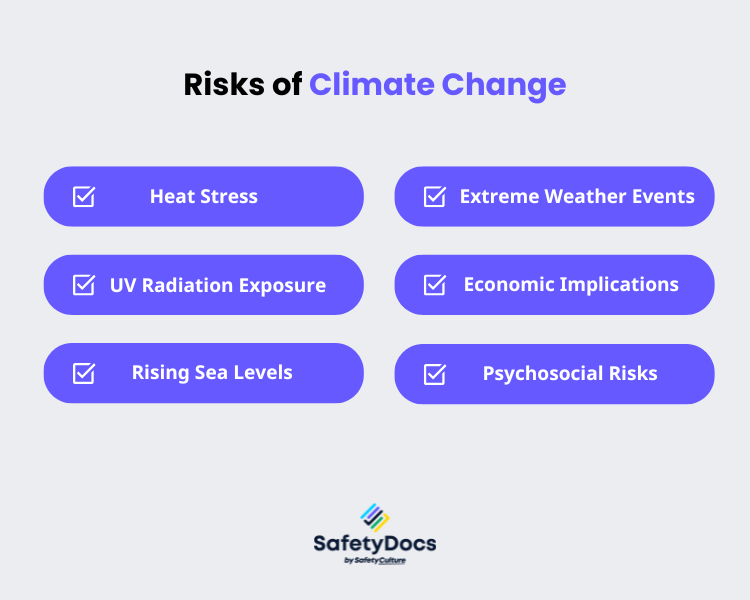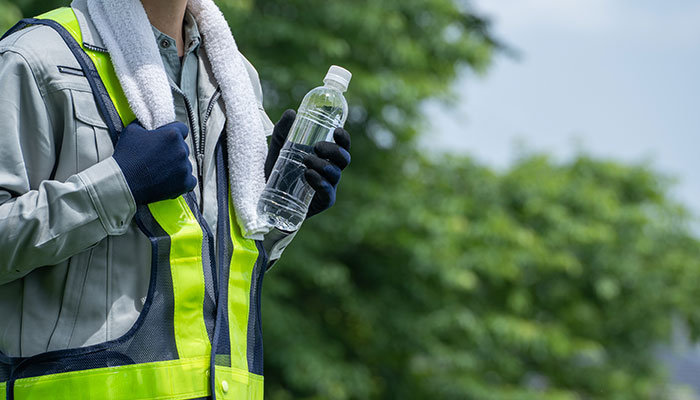Under the Work Health and Safety (WHS) laws, employers (PCBUs) are required to ensure a safe work environment for workers. This includes minimising risks associated with the impacts of climate change. Australia's average temperatures have risen by 1.51°C from 1910 to 2023. A global average temperature increase of 1.5°C is a critical benchmark in global climate change assessments.
This increase shows warming aligning with global thresholds, resulting in significant climate impacts. The effects of changing climate are already being felt globally, with more frequent and severe extreme weather incidents occurring. Let's explore the effects of the climate crisis on workplace safety and how businesses can prepare for these challenges.
Risks of Climate Change
Climate change is the long-term alteration of global temperatures, precipitation patterns, and other weather conditions. It is increasingly acknowledged as a major factor impacting Australia's human health and workplace safety. It presents a range of environmental challenges that threaten the health and safety of workers, such as:
Heat Stress
Research shows that heat stress is a growing occupational health risk in Australia, especially for outdoor and weather-exposed workers. It impacts physical health, mental alertness, and productivity. In extreme cases, it can be fatal; heat stress causes over 1,100 deaths annually in Australia.
Climate change may also cause the loss of 700,000 to 2.7 million workdays annually by 2061 due to heat stress and extreme weather. Workers at high risk include:
- Indoor workers in poorly climate-controlled environments, like factories and warehouses
- Weather-exposed outdoor workers, like construction and agriculture workers
- Workers moving between hot and cold temperatures, like
- Emergency workers and firefighters facing extreme heat
UV Radiation Exposure
According to the International Labour Organization's 2024 report, Australian workers are at a greater risk of exposure to ultraviolet (UV) radiation than their global counterparts. This increased risk is primarily due to ozone layer depletion. Australia's proximity to Antarctica, where the ozone hole forms annually, exacerbates the issue. During spring in the Southern Hemisphere, the ozone hole reaches its maximum size, permitting higher levels of UV radiation to penetrate the atmosphere.
Australia has recognised and addressed the thinning ozone layer since the late 1980s. However, the impact of UV radiation still affects Australian workers, as it causes a range of health issues such as:
- Sunburn and skin cancer
- Eye damage, including cataract formation and increasing risk of blindness
- Immune suppression affecting illness recovery times
Rising Sea Levels
Rising sea levels present serious challenges to workplace safety, particularly for businesses in coastal or low-lying regions. They are projected to increase by 45 to 82 cm by 2090, threatening coastal infrastructure, marine life, and habitats where about 90% of Australians live. By 2061, between 39,000 and 46,000 properties may be exposed to coastal erosion or flooding.
Extreme Weather Events
The frequency and severity of extreme weather events, such as bushfires, tropical storms, extreme rainfall, and floods, are increasing due to climate change. These events can significantly impact workplace safety, leading to injuries and fatalities. During 2019-2020, Australia faced a severe bushfire season, burning approximately 17 million hectares, marking a record-breaking disaster. Poor air quality resulting from bushfire smoke can cause respiratory problems among workers.
Such events pose indirect workplace risks, such as property damage, power outages, supply chain and food production disruptions, and economic loss. These impacts can result in business interruptions and financial strain for businesses.
Economic Implications
Due to more frequent and severe weather events like bushfires, floods, and droughts, climate-related disasters could cost Australia about $73 billion each year by 2060. In fact, the Black Summer Bushfires caused over $100 billion in damages, including property loss and recovery costs. These large economic losses can significantly impact businesses, particularly small to medium enterprises in rural communities.
Psychosocial Risks
Climate change does not only present physical health threats to workers. It also poses psychosocial risks. Psychosocial risks are stressors in the work environment that may lead to psychological or physiological harm.
Climate change and global warming-related natural disasters can generate significant emotional distress for workers, leading to issues such as post-traumatic stress disorder (PTSD). Another psychosocial impact of climate change is job uncertainty. As the changing environment affects industries and jobs, workers may experience mental health problems like anxiety and stress over the current and future impacts, potential job loss or changes in work duties.

Preparation and Mitigation
As temperatures rise and the effects of climate change continue to be felt globally, businesses need to prepare for extreme weather events. Here are some steps businesses can take to prepare and mitigate the risks of climate change on workplace safety:
Conduct Climate-Related Risk Assessments
1. Start by assessing your business and its workers' vulnerability to climate change.
Start by assessing your business and its workers' vulnerability to climate change. Identify extreme weather events or climate hazards that could impact your operations, such as flooding, bushfires, heatwaves, or cyclones, depending on your location. Use local climate projections and risk assessment tools tailored for Australia, such as Climate Change in Australia (CSIRO and Bureau of Meteorology), or the Australian Climate Service. These tools provide detailed insights into future climate trends and help you understand the specific risks in your region. Many local councils also offer hazard maps and planning resources, which can be invaluable for regional assessments.
2. Make a comprehensive list of your assets and operations, such as:
- Physical locations (offices, warehouses, retail spaces, suppliers)
- Critical infrastructure and machinery
- Supply chains, especially partners located in high-risk areas
- Systems and processes critical for day-to-day operations
3. Document Findings
Capture the outcomes in a risk assessment matrix. Incorporate information from safety documents, ranking hazards by level of concern. Assign teams responsibility for addressing high-priority risks.
Here are tools you can use for your vulnerability assessment:
- Climate Risk Management Frameworks such as ISO 14090 (Adaptation to climate change) and ISO 31000 (Risk Management)
- Geographic Information System (GIS) tools to assess physical risks on maps
- Risk platforms like Climate Central or ICLEI for climate risk data
- Safety Documents
Incorporate Climate-Related Risk Assessments Into BCP Development
Once you've identified vulnerabilities, you need a robust plan to address potential disruptions caused by climate-related risks. The Business Continuity Plan (BCP) helps organisations prepare to face these challenges. It outlines procedures and resources that enable an organisation to resume essential functions in case of business disruption due to climate change.
Implement Preventative Measures for Extreme Weather
The best way to mitigate the impact of extreme weather events is to prevent them from happening, where possible. Here are some measures you can take:
1. Hot Conditions Safety Policy
A Hot Conditions Safety Policy is a comprehensive strategy designed to prevent heat-related illnesses in the workplace. It involves implementing administrative controls such as:
- Adjusting work schedules to avoid peak heat times.
- Providing regular breaks in shaded or air-conditioned areas.
- Establishing clear protocols for recognising and responding to signs of heat-related illness
- Designate responsible individuals to monitor environmental conditions (temperature and humidity) and worker health.

2. Flood and Storm Preparedness
Preparing for floods and storms involves:
- Reinforcing Structures: Ensure buildings, roofs, doors, and windows are secure enough to withstand extreme weather.
- Weather Monitoring Systems: These can detect changes in weather and alert workers to potential hazards.
3. Air Quality Controls
Air quality monitoring and management are essential in workplaces impacted by air pollution. Here are some actions you can take to prevent or reduce the impact of poor air quality on workers:
- Installing air scrubbers, ventilation systems, and filters.
- Providing personal protective equipment (PPE) like respirators or masks.
- Set thresholds based on air quality index (AQI) ratings
Conduct Emergency Response Planning and Training
Emergency preparedness doesn't end with preventative measures alone. Workplaces must also have an emergency response plan and provide appropriate training. Some key components of a comprehensive emergency response plan include:
- Evacuation procedures: Establish clear protocols for evacuating employees during a disaster.
- Emergency communication: Set up a system to quickly and effectively communicate with workers during emergencies. This could include text alerts, email notifications, or designated emergency contact persons.
- Employee training and drills: Conduct regular training to ensure workers are familiar with emergency protocols.
- First aid and medical assistance: Ensure adequate equipment is on-site and designated individuals are trained in first aid and CPR.
Leverage Technology for Climate Adaptation
Lastly, businesses can also take advantage of technology to adapt to the effects of climate change. Here are four key technologies to utilise for climate action:
- Early Warning Systems: Real-time tools like IoT sensors and automated alerts monitor the weather and prepare for extreme events to enhance safety and minimise losses.
- Sustainable Building Practices: Features like green roofs and smart HVAC systems boost energy efficiency and resilience, reducing costs and protecting assets.
- Data Analytics: Analysing climate data with tools like predictive modelling helps identify vulnerabilities and optimise resource use for future scenarios.
- Internet of Things (IoT): IoT devices such as sensors, drones, and wearables can collect real-time data on temperature, humidity, air quality, etc., providing insights into workplace conditions.
Solidify Climate Change Preparedness with SafetyDocs
Equip your business with ready-to-use templates to manage extreme weather risks effectively. SafetyDocs by SafetyCulture offers a comprehensive library of digital safety templates, including emergency response plans, management plans, and more.
Stay ahead of the environmental changes happening in the workplace with SafetyDocs by your side. Explore our library today and take steps towards climate preparedness.
- Hot Conditions Risk Assessment Form
- Hot Conditions Safety Policy
- Heat Stress Safe Work Method Statement
- Emergency Response Procedure - Fire
- Disaster Recovery Plan
Contact us to learn how SafetyDocs can help your business with climate resilience and emergency preparedness.
Our team of experts is dedicated to providing accurate and informative content. Craig Cruickshank, our senior HSEQ advisor at SafetyDocs by SafetyCulture has reviewed this blog post to ensure the highest level of quality.
Learn more about Craig's work on LinkedIn for more industry insights.
Available for instant download and supplied in fully editable MS Word format for use in your business.
Please note that the above information is provided as a comment only and should not be relied on as professional, legal or financial advice.
Share This Article
